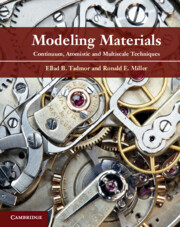Book contents
- Frontmatter
- Contents
- Preface
- Acknowledgments
- Notation
- 1 Introduction
- Part I Continuum mechanics and thermodynamics
- Part II Atomistics
- 3 Lattices and crystal structures
- 4 Quantum mechanics of materials
- 5 Empirical atomistic models of materials
- 6 Molecular statics
- Part III Atomistic foundations of continuum concepts
- Part IV Multiscale methods
- Appendix A Mathematical representation of interatomic potentials
- References
- Index
3 - Lattices and crystal structures
from Part II - Atomistics
Published online by Cambridge University Press: 05 June 2012
- Frontmatter
- Contents
- Preface
- Acknowledgments
- Notation
- 1 Introduction
- Part I Continuum mechanics and thermodynamics
- Part II Atomistics
- 3 Lattices and crystal structures
- 4 Quantum mechanics of materials
- 5 Empirical atomistic models of materials
- 6 Molecular statics
- Part III Atomistic foundations of continuum concepts
- Part IV Multiscale methods
- Appendix A Mathematical representation of interatomic potentials
- References
- Index
Summary
Crystalline materials were known from ancient times for their beautiful regular shapes and useful properties. Many materials of important technological value are crystalline, and we now understand that their characteristics are a result of the regular, repeating arrangement of atoms making up the crystal structure. The details of this crystal structure determine, for example, the elastic anisotropy of the material. It helps determine whether the crystal is ductile or brittle (or both depending on the direction of the applied loads). The crystallinity manifests itself in structural phase transformations, where materials change from one crystal structure to another under applied temperature or stress. Defects in crystals (discussed in Chapters 1, 6 and 12) determine the electrical and mechanical response of the material. Indeed, we saw in Chapter 1 that the starting point for understanding any of the properties of crystalline materials is the understanding of the underlying crystal structure itself.
Crystal history: continuum or corpuscular?
The evolution of the modern science of crystallography was a long time in coming. Here, we present a brief overview, partly based on the fascinating detailed history of this science in the article by J. N. Lalena [La106].
Prehistoric man used flint, a microcrystalline form of quartz peppered with impurities, to make tools and weapons. Most likely he never concerned himself with the inner structure of the material he was using. If pressed he would probably have adopted a continuum view of his material since clearly as he formed his tools the chips flying off were always just smaller pieces of flint.
- Type
- Chapter
- Information
- Modeling MaterialsContinuum, Atomistic and Multiscale Techniques, pp. 115 - 152Publisher: Cambridge University PressPrint publication year: 2011



